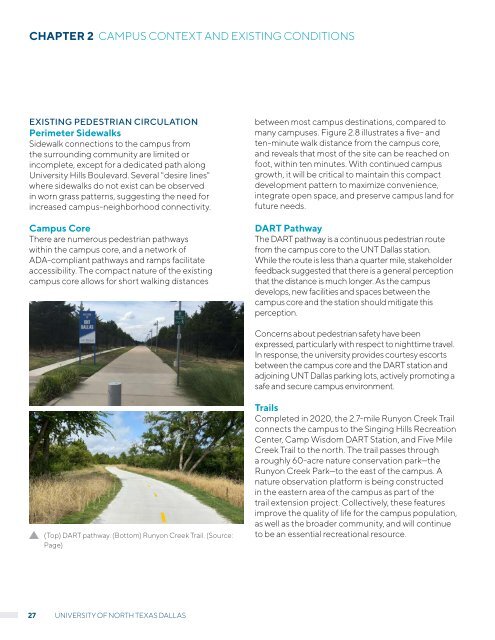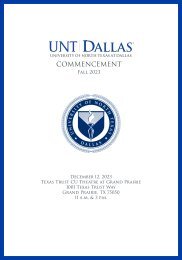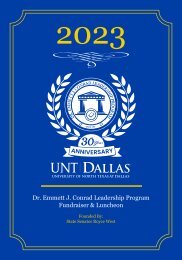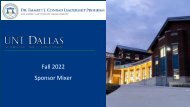UNT Dallas 2020 Master Plan
You also want an ePaper? Increase the reach of your titles
YUMPU automatically turns print PDFs into web optimized ePapers that Google loves.
CHAPTER 2 CAMPUS CONTEXT AND EXISTING CONDITIONS<br />
EXISTING PEDESTRIAN CIRCULATION<br />
Perimeter Sidewalks<br />
Sidewalk connections to the campus from<br />
the surrounding community are limited or<br />
incomplete, except for a dedicated path along<br />
University Hills Boulevard. Several "desire lines"<br />
where sidewalks do not exist can be observed<br />
in worn grass patterns, suggesting the need for<br />
increased campus-neighborhood connectivity.<br />
Campus Core<br />
There are numerous pedestrian pathways<br />
within the campus core, and a network of<br />
ADA-compliant pathways and ramps facilitate<br />
accessibility. The compact nature of the existing<br />
campus core allows for short walking distances<br />
between most campus destinations, compared to<br />
many campuses. Figure 2.8 illustrates a five- and<br />
ten-minute walk distance from the campus core,<br />
and reveals that most of the site can be reached on<br />
foot, within ten minutes. With continued campus<br />
growth, it will be critical to maintain this compact<br />
development pattern to maximize convenience,<br />
integrate open space, and preserve campus land for<br />
future needs.<br />
DART Pathway<br />
The DART pathway is a continuous pedestrian route<br />
from the campus core to the <strong>UNT</strong> <strong>Dallas</strong> station.<br />
While the route is less than a quarter mile, stakeholder<br />
feedback suggested that there is a general perception<br />
that the distance is much longer. As the campus<br />
develops, new facilities and spaces between the<br />
campus core and the station should mitigate this<br />
perception.<br />
Concerns about pedestrian safety have been<br />
expressed, particularly with respect to nighttime travel.<br />
In response, the university provides courtesy escorts<br />
between the campus core and the DART station and<br />
adjoining <strong>UNT</strong> <strong>Dallas</strong> parking lots, actively promoting a<br />
safe and secure campus environment.<br />
(Top) DART pathway. (Bottom) Runyon Creek Trail. (Source:<br />
Page)<br />
Trails<br />
Completed in <strong>2020</strong>, the 2.7-mile Runyon Creek Trail<br />
connects the campus to the Singing Hills Recreation<br />
Center, Camp Wisdom DART Station, and Five Mile<br />
Creek Trail to the north. The trail passes through<br />
a roughly 60-acre nature conservation park—the<br />
Runyon Creek Park—to the east of the campus. A<br />
nature observation platform is being constructed<br />
in the eastern area of the campus as part of the<br />
trail extension project. Collectively, these features<br />
improve the quality of life for the campus population,<br />
as well as the broader community, and will continue<br />
to be an essential recreational resource.<br />
27<br />
UNIVERSITY OF NORTH TEXAS DALLAS


















